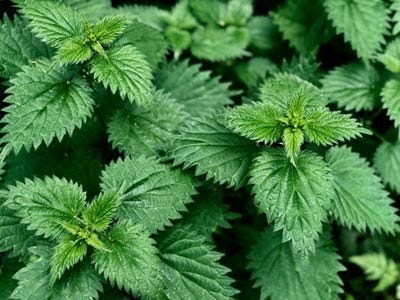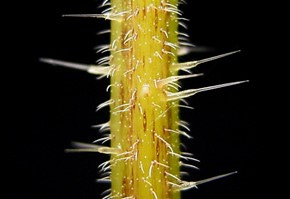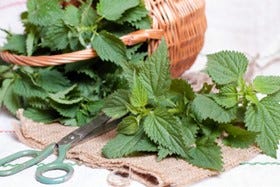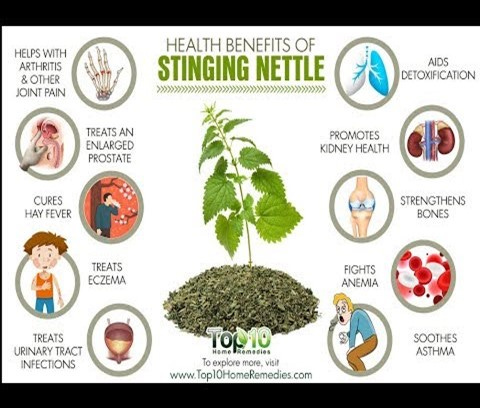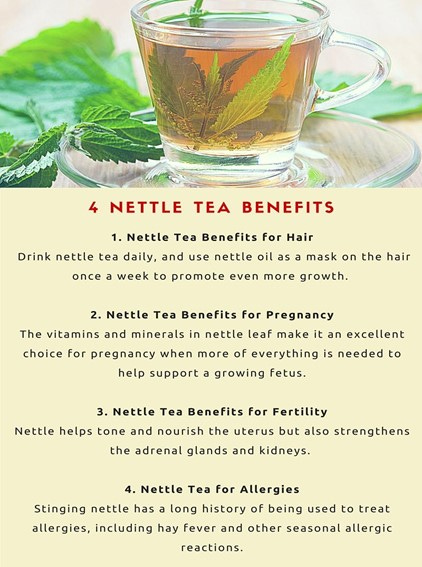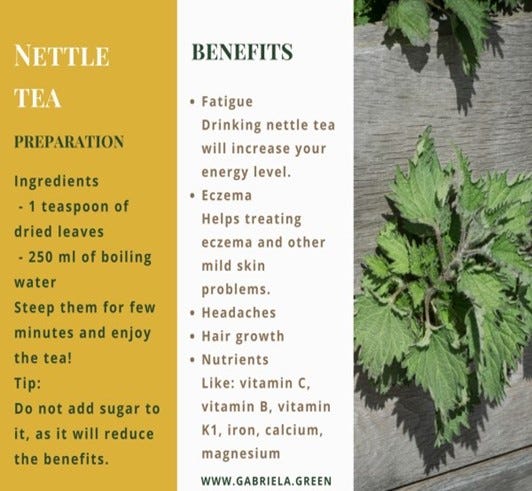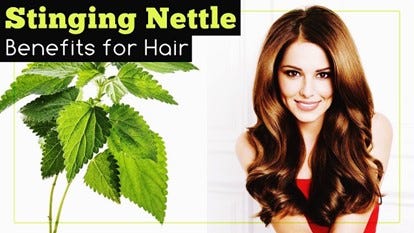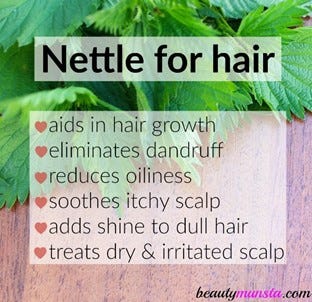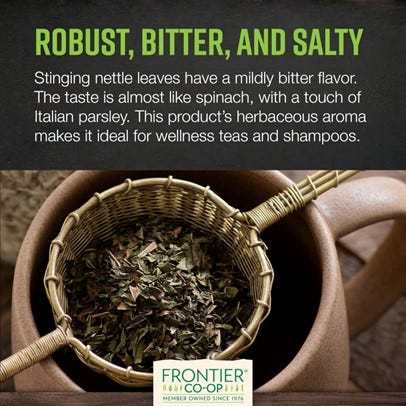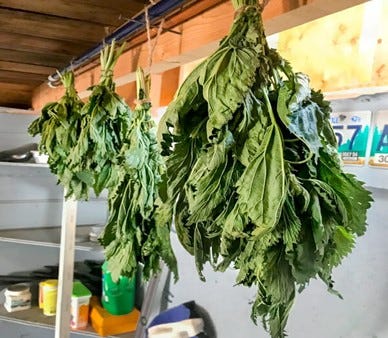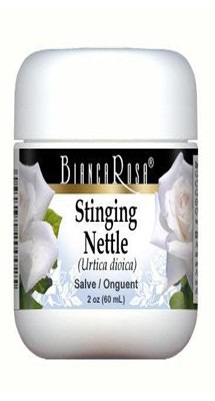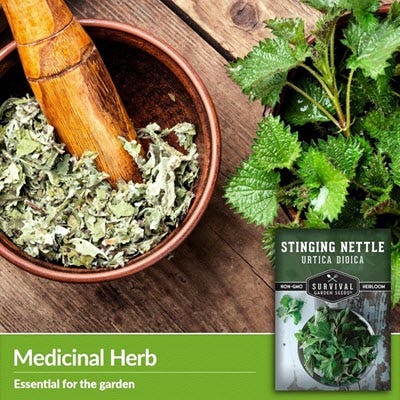STINGING NETTLE: NATURES HEALING SUPERFOOD
If you have spent any significant time gardening, then it is very likely that you are already familiar with the reason stinging nettle has that name. Damn does it hurt. It is like getting little glass slivers under your skin. It is like grabbing a cactus that has fine small needles like a prickly pear cactus. However, as far as a useful plant, stinging nettle has proven its worth to mankind over thousands of years!
Stinging Nettle plants are botanically known as Urtica dioica
KINKY FACT/NERD FOOD: SKIP THIS IF YOU DON’T CARE ABOUT WHERE STINGING NETTLES NAME IS DERIVED. The botanical name of stinging nettle gives you many clues to how it is perceived by man. Urtica comes from the term urticaria which means causes stinging or hives, caused by skin coming into contact with the tiny hollow syringe like needles of the stinging nettle plant that inject histamine under the skin causing it to swell into a hive. The needles are easily removed by rubbing against the plant.
The second part of its name comes from the Greek word dioecious meaning “having come from two houses.” It is thus named because the plants have either male or female parts, and hence a female plant requires a male pollinator. So, by its name Urtica dioecian we know that it is a plant that stings and causes hives and the females need a male pollinator.
Stinging nettle was originally only found in Europe. However, it has now spread worldwide. It has been used medicinally by mankind for thousands of years. The Egyptians used it to treat arthritis and lower back pain. The Romans cleverly used it to warm up cold limbs and to keep soldiers awake on overnight watch duty.
Used as a supplement, it has many benefits without the sting, because when you dry it, or cook it, it loses its sting and the needles break down. What you are left with is a nutritional powerhouse.
The nutritional profile of stinging nettle is quite impressive. Stinging nettle’s leaves and root provide a wide variety of nutrients, some of which are powerful antioxidants. the following list shows what a nutritional punch it has:
Vitamins: Vitamins A, C, and K, as well as several B vitamins
Minerals: Calcium, iron, magnesium, hosphorus, potassium, and sodium
Fats: Linoleic acid, linolenic acid, palmitic acid, stearic acid, and oleic acid
Amino acids: All the essential amino acids. Remember, essential means your body cannot make them as it can the non-essential amino acids, hence you have to get them from diet.
Polyphenols: Kaempferol, quercetin, caffeic acid, coumarins, and other flavonoids. Polyphenols are always good for you due to their multiple health enhancing effects.
Pigments: Beta-carotene, lutein, luteoxanthin, and other carotenoids
In addition to which stinging nettle also has many health benefits beyond its powerful nutritional punch:
Antioxidant
Helps joint pain and arthritis and treats osteoporosis
Improves blood circulation and cardiovascular health
Treats seasonal allergies such as Hay Fever acting ironically as an antihistamine
Helps female and male sexual health and menopausal symptoms
Controls blood glucose levels
Stinging nettle is very often taken as a tea. I have never tasted it but it is supposed to be delicious.
Here are some additional benefits of drinking stinging nettle tea:
As it turns out, many alternative medicine practitioners use stinging nettle for hair and skin problems, such as seborrheic dermatitis of scalp, dandruff and itchy scalps, eczema, and psoriasis all respond nicely to it. It is also widely used to help aid in wound healing. I routinely also use vitamin C, collagen, and zinc to promote wound healing.
For long term healing of skin diseases such as psoriasis and eczema I also add omega-3 fatty acids from either fish oil or krill oil.
For both skin and hair problems it can be used topically from either leaf or root tinctures or a creamy salve.
Stinging Nettle has various skin benefits such as:
Anti-inflammatory properties
Antioxidant effects
Antimicrobial action (helps treat skin infections)
Astringent properties (dries out oily skin)
HOW THE MEDICAL UNDERGROUND USES STINGING NETTLE
First of all, when using stinging nettle, you have a variety of choices of how it is delivered. You can drink a tea to get the systemic (whole body) benefits, apply it topically to hair and skin problems, or you can take it in supplement form in either capsules or tablets.
All of which as usual is available on Amazon. God do I hate Jeff Bezos and everything he stands for, but Amazon is the go to place for just about everyone, it is the Sears and Robuck of the 21st Century.
Hence, depending upon what part of your body you are treating or whether you are treating your entire body, you have many options available to you.
WHAT PART OF STINGING NETTLE CAN YOU EAT?
Incredibly, you can eat the stems, roots, seeds, leaves, and young shoots, all of which are edible, and jam packed full of nutrients.
Tall mature stinging nettle plants can also be used to make textiles and even rope. (The greatest plant for rope making is marijuana used in the form of hemp worldwide.)
If you are growing it, the first thing you do is harvest the entire plant hang it upside down in a dark basement or shed and dry it. The first benefit of this is that it completely removes the stingers. You can also use a dehydrator to dry the plant so you can harvest it for whatever uses you had in mind.
It will take from one to three weeks for them to dry well, make sure there is good air ventilation, and it is dark.
Once dried you can store it in either glass Mason jars or paper bags, do not use plastic due to moisture and mold buildup as well as microplastic contamination.
Once you have the leaves, roots, and stems dried, you can make whatever concoction you desire, be it tea, or pounding it into a salve, or taking the leaves and cooking them. Supposedly it has a taste like spinach and is enhanced with some lemon juice sprinkled on top.
Various companies offer tinctures made from either the leaves or roots, most often the roots. This usually is bitter in taste; some companies add glycerin to sweeten it and remove that bitter aftertaste.
Stinging nettle is also available as supplements in capsule form. The doses vary wildly, from 250 mg to 7,500 mg. The good news is it is so well tolerated that there is no difference in the side effects. As always, I recommend starting low and slowly increase the dose to see how you respond.
There is an entire host of stinging nettle shampoos available online. I would use this every other day to see your response. If it is good then keep it that way, if not increase to daily use.
There is also a variety of topical creams and salves available to treat eczema, psoriasis, and any skin irritations. The Medical Underground recommends using these topical preparations twice daily, rubbing it in well.
Finally, if you want to grow stinging nettle, it is a weed and very easy to grow anywhere in the continental United States. Seeds are available from nurseries as well as online and are very inexpensive. If you are creating a survival medicine chest, then I would add a couple of packets of these inexpensive seeds.
Always buy open pollinated heirloom seeds, not hybrids. This way you can harvest your own seeds each year from your plants and have a continuous supply of free plants.
Here is what the seed heads look like on the plant. Keep in mind when you are planting stinging nettle that it grows best in full sun, but will thrive in part shade as well, and grows from 3 to 7 feet in height!
Be careful when planting stinging nettle since it is VERY INVASIVE AND SPREADS FROM UNDERGROUND STALONS. Keep this in mind and find a corner of your property that you don’t care about.
How do I harvest stinging nettle for eating?
While all parts of the nettle plant are edible, the leaves and stems can’t be eaten straight from the plant due to the barbs. Instead, you must thoroughly cook the plant before eating it to deactivate its stinging potential. When the plant is uncooked it is toxic.
Harvesting involves cutting back the top third of the plant, just above a node where leaves branch out. This will encourage new growth. The leaves will have the best flavor in cooking if they are harvested before the plant flowers. After this, the leaves become somewhat tough and stringy. The leaves of stinging nettle can be used in the same way — and in the same recipes — as you would use cooked spinach.
You have just learned all about Stinging Nettle in yet another exciting episode of The Medical Underground. As always, I hope you found it both useful, educational, and hopefully entertaining as well. If you have not already become a subscriber than please show me how much you appreciate all my hard work and hit that subscribe button now!
If you are already a free subscriber, PLEASE SHOW ME THAT YOU APPRECIATE ALL THIS CUTTING-EDGE MEDICAL RESEARCH AND STEP UP YOUR GAME AND BECOME A PAID SUBSCRIBER. I WOULD REALLY APPRECIATE THAT.
Until next week’s fascinating article, May God Bless You and Your Family and the United States of America. For those of you who, like me, are believers in Jesus Christ, always remember that for us: Miracle Shall Follow Miracle and Wonders Shall Never Cease.
This disclaimer provides that such medical information is merely information – not advice.
If users need medical advice, they should consult their doctor or other appropriate medical professional.




